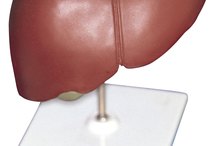Low Platelet Count & Fatty Liver Disease
According to the seventh edition of Williams Hematology, the primary causes of low platelet count in individuals with liver disease are sequestration of platelets in the spleen as a consequence of portal hypertension and decreased production of thrombopoietin by the liver. Fatty liver disease is characterized by excess fat in liver cells and has various causes.
Portal Hypertension and Low Platelets
The portal vein is a blood vessel that brings blood from the stomach, pancreas, spleen, small intestine, and most of the colon to the liver for purification before returning it to the heart. In severe liver disease the portal vein develops a high blood pressure because the damaged liver does not readily accept the incoming flow of blood. The high pressure in the portal vein impedes flow of blood out of the spleen, and platelets become sequestered in the spleen.
Decreased Thrombopoietin and Low Platelets
Low Platelet Count & Fatty Liver Disease
Learn More
Thrombopoietin is a hormone produced by the liver that regulates the production of platelets. Fatty liver disease can result in a liver that is dysfunctional and does not adequately produce thrombopoietin.
Other Potential Causes of Low Platelets in Fatty Liver Disease
In cases of alcohol-induced fatty liver disease, low platelet count can be caused by deficiency of vitamin B9 and by alcohol toxicity to platelet synthesis.
Causes of Fatty Liver Disease
L-Arginine and Fatty Liver Disease
Learn More
Causes of fatty liver include alcohol toxicity, obesity, high blood triglycerides, use of certain prescription drugs, poison ingestion, endocrine diseases, polycystic ovary syndrome, hypobetalipoproteinemia and other metabolic disease such as diabetes mellitus, obstructive sleep apnea, starvation, and total parenteral nutrition.
Other Signs and Symptoms of Fatty Liver Disease
Fatty liver disease is generally asymptomatic but may manifest as right upper abdominal pain. Laboratory studies may reveal increased liver enzymes called transaminases. Physical examination or diagnostic imaging may reveal an enlarged liver.
Related Articles
References
Resources
Writer Bio
Marie Bell has earned a Bachelor of Science in sports medicine and is currently working toward a Doctor of Medicine. She has a passion for health and wellness and shares her knowledge in her writing.









